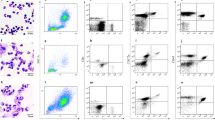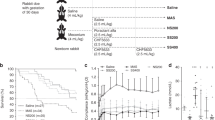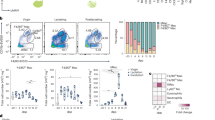Abstract
The diagnosis of recurrent aspiration in young children is a perpetual challenge because there is no specific gold standard test to be used. The finding of lipid-laden alveolar macrophages in bronchoalveolar lavage (BAL) is a sensitive but nonspecific marker for the diagnosis of aspiration. We conducted a short-term study comparing tracheal instillation of saline, milk, or a milk-charcoal mixture in hamsters. BAL cytology, lipid-laden alveolar macrophage index, charcoal alveolar macrophage index, and lung histology were monitored for 10 d. A long-term study was performed, and hamsters were monitored for 92 d after milk-charcoal tracheal instillation. Baseline animals (n = 4) had no tracheal instillation. Saline- and milk-instilled animals had BAL performed after 1 (n = 4), 3 (n = 4), and 10 (n = 4) d. Milk-charcoal–instilled animals had BAL performed after 1 (n = 4), 3 (n = 4), 10 (n = 4), 30 (n = 2), 58 (n = 2), and 92 (n = 2) d after tracheal instillation. Total cell counts and percent neutrophils in BAL fluid increased significantly and similarly after milk and milk-charcoal instillation on d 1 compared with baseline and saline-instilled animals. Lipid-laden alveolar macrophage index increased significantly only on d 3 after milk and milk-charcoal instillation compared with all days in the saline-instillation group. Charcoal alveolar macrophage index increased significantly after milk-charcoal instillation (d 1–58) from baseline or all days in the saline-instillation group. We conclude that charcoal particles instilled in tracheas of hamsters can be easily identified in BAL fluid and in lung parenchyma for as long as 3 mo after a single instillation and could potentially be used as a sensitive, specific, and stable marker for the diagnosis of aspiration, although the issue of its applicability to humans is still unsolved.
Similar content being viewed by others
Log in or create a free account to read this content
Gain free access to this article, as well as selected content from this journal and more on nature.com
or
Abbreviations
- BAL:
-
bronchoalveolar lavage
- ChAM:
-
charcoal alveolar macrophage
- LLAM:
-
lipid-laden alveolar macrophage
References
Heyman S, Kirkpatrick JA, Winter HS, Treves S 1979 An improved radionuclide method for the diagnosis of gastroesophageal reflux and aspiration in children (milk scan). Radiology 131: 479–482
McVeagh P, Howman-Giles R, Kemp A 1987 Pulmonary aspiration studied by radionuclide milk scanning and barium swallow roentgenography. Am J Dis Child 141: 917–921
Corwin RW, Irwin RS 1985 The lipid-laden alveolar macrophage as a marker of aspiration in parenchymal lung disease. Am Rev Respir Dis 132: 576–581
Langston C, Pappin A 1996 Lipid-laden alveolar macrophages as an indicator of aspiration pneumonia. Arch Pathol Lab Med 120: 326–327
Elidemir O, Fan LL, Colasurdo N 2000 A novel diagnostic method for pulmonary aspiration in a murine model: immunocytochemical staining of milk proteins in alveolar macrophages. Am J Respir Crit Care Med 161: 622–626
Mallory FB 1942 Pathological Technique. WB Saunders Co, Philadelphia, 118
Colombo JL, Hallberg TK, Sammut PH 1992 Time course of lipid-laden pulmonary macrophages with acute and recurrent milk aspiration in rabbits. Pediatr Pulmonol 12: 95–98
Coonrod JD, Varble R, Jarrels MC 1990 Species variation in the mechanism of killing of inhaled pneumococci. J Lab Clin Med 116: 354–362
Knauer-Fischer S, Ratjen F . Lipid-laden macrophages in bronchoalveolar lavage fluid as a marker for pulmonary aspiration. Pediatr Pulmonol 27: 419–422 1999
Recalde AL, Nickerson BG, Vegas M, Scott CB, Landing DH, Warburton D 1984 Lipid-laden macrophages in tracheal aspirates of newborn infants receiving intravenous lipid infusions: a cytologic study. Pediatr Pathol 2: 25–34
Kajetanowicz A, Stinson D, Laybolt KS, Resch L 1999 Lipid-laden macrophages in the tracheal aspirate of ventilated neonates receiving intralipid: a pilot study. Pediatr Pulmonol 28: 101–108
Cohen AB, Cline MJ 1972 In vitro studies of the foamy macrophage of postobstructive endogenous lipoid pneumonia in man. Am Rev Respir Dis 106: 69–78
Desai R, Tetley TD, Curtis CG, Powell GM, Richards RJ 1978 Studies on the fate of pulmonary surfactant in the lung. Biochem J 176: 455–462
Neunoven PJ, Olkkola KT 1988 Oral activated charcoal in the treatment of intoxications. Role of single and repeated doses. Med Toxicol Adverse Drug Exp 3: 33–58
McLuckie A, Forbes AM, Ilett KF 1990 Role of repeated doses of oral activated charcoal in the treatment of acute intoxications. Anaesth Intensive Care 18: 375–384
Harris CR, Filandrinos D 1993 Accidental administration of activated charcoal into the lung: aspiration by proxy. Ann Emerg Med 22: 1470–1473
Rau NR, Nagaraj MV, Prakash PS, Nelli P 1988 Fatal pulmonary aspiration of oral activated charcoal. [letter]. BMJ 297: 918–19
Elliot CG, Colby TV, Kelly TM, Hicks HG 1989 Charcoal lung: bronchiolitis obliterans after aspiration of activated charcoal. Chest 96: 672–674
Author information
Authors and Affiliations
Corresponding author
Rights and permissions
About this article
Cite this article
Avital, A., Yoav, S. & Springer, C. Charcoal Is a Sensitive, Specific, and Stable Marker for the Diagnosis of Aspiration in Hamsters. Pediatr Res 51, 397–401 (2002). https://doi.org/10.1203/00006450-200203000-00021
Received:
Accepted:
Issue date:
DOI: https://doi.org/10.1203/00006450-200203000-00021



